At Ayurvedic Healing Village, the eternal science of Ayurveda is treated with reverence and is practised as a legacy with the honesty it deserves.
◊ By Dr Supriya Mahajan Sardana, MD
Visit ORGANIC SHOP by Pure & Eco India
Did you ever stop to think and forget to start again?”
Coming from Winnie the Pooh, the query seems simple enough, but think about it (pun intended). Perhaps, Winnie the Pooh’s creator, A A Milne, was referring to a state which eludes even the most serious of meditators, when the tiresome and continuous stream of thoughts called the ‘human mind’ takes a pause, time notwithstanding.
One such instance where I could answer Winnie in the affirmative was while lying on an ageless, wooden massage table or droni*, with warm, herb-energised oil being poured on my head under the deft hands of a Keralite masseuse. The process is aptly named Shirodhara and the venue is Kairali – The Ayurvedic Healing Village (KHV) in Palakkad, Kerala. The context is Health through Ayurveda in the lap of Nature.
WHY AM I HERE?
I have been lucky so far to not have been labelled with a certain diagnosis. Hence, the responsibility of mine and my family’s health and wellbeing falls upon me and not on doctors. I prefer to do so by all means natural. On my journey of preventing disease and enjoying good health, a few years ago, I found a powerful ally which is centuries old, comes from the Divine realm, yet whose principles are universally applicable to every individual irrespective of age, financial status, religion or nationality.
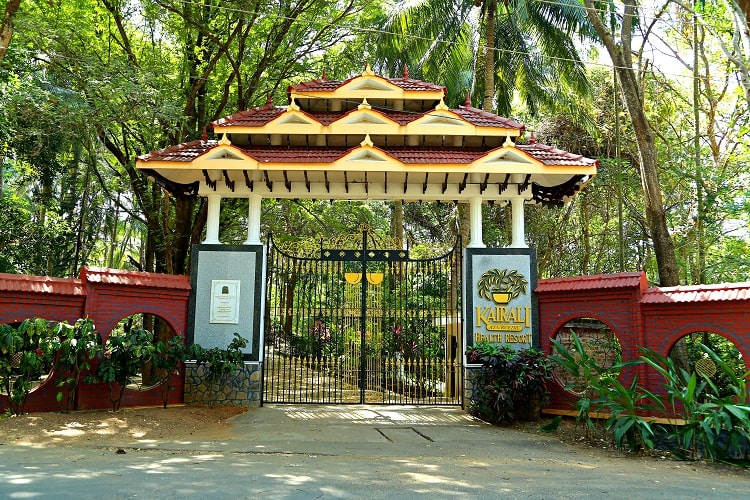
This unifying system of healing is the Science of Life and Longevity, Ayurveda. The guiding principles of Ayurveda have been an integral part of my life and my kitchen.
In the course of one’s spiritual evolution, Ayurveda is the foundation as it can enable an individual to achieve harmony with the Cosmos. Hence, when the time came for me to delve deeper into this unfathomable well of ancient wisdom, I chose a place where this eternal science is treated with reverence and has been practised as a legacy, with the honesty that it deserves.
“On my journey of preventing disease and enjoying good health, I found a powerful ally which is centuries old and comes from the Divine realm, and yet is applicable to everyone, regardless of age, financial status, religion or nationality—Ayurveda”
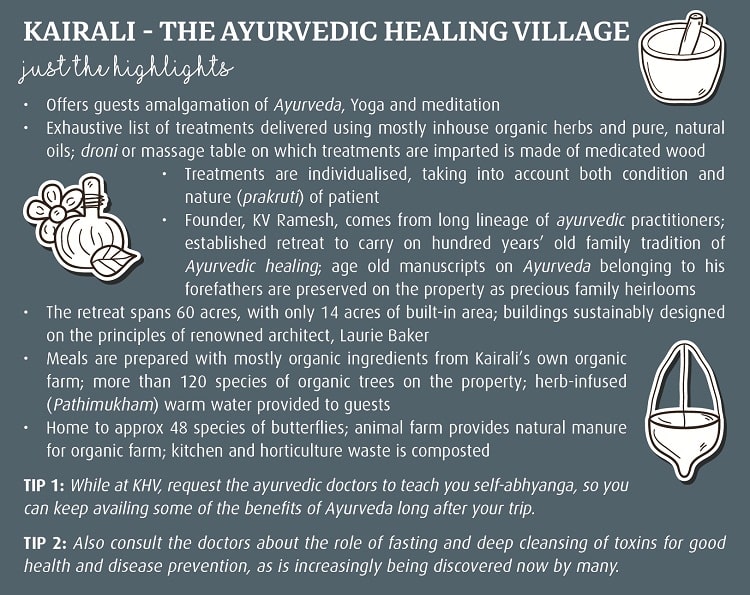
A GREEN RETREAT
Amidst the serene environs, our journey unfurled at the reception. Age old manuscripts on Ayurveda belonging to the forefathers of the founder, have been painstakingly preserved as family heirlooms and hold a place of the highest regard here.
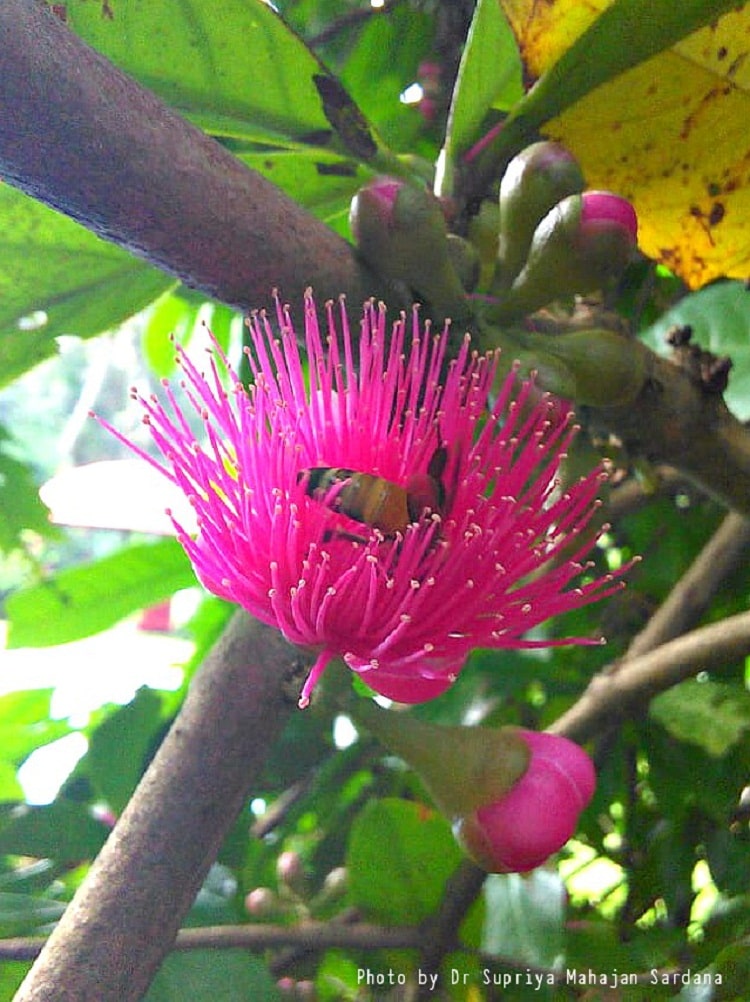 The stunning pink blossoms of a Water Apple tree—feast for birds, bees and human eyes |
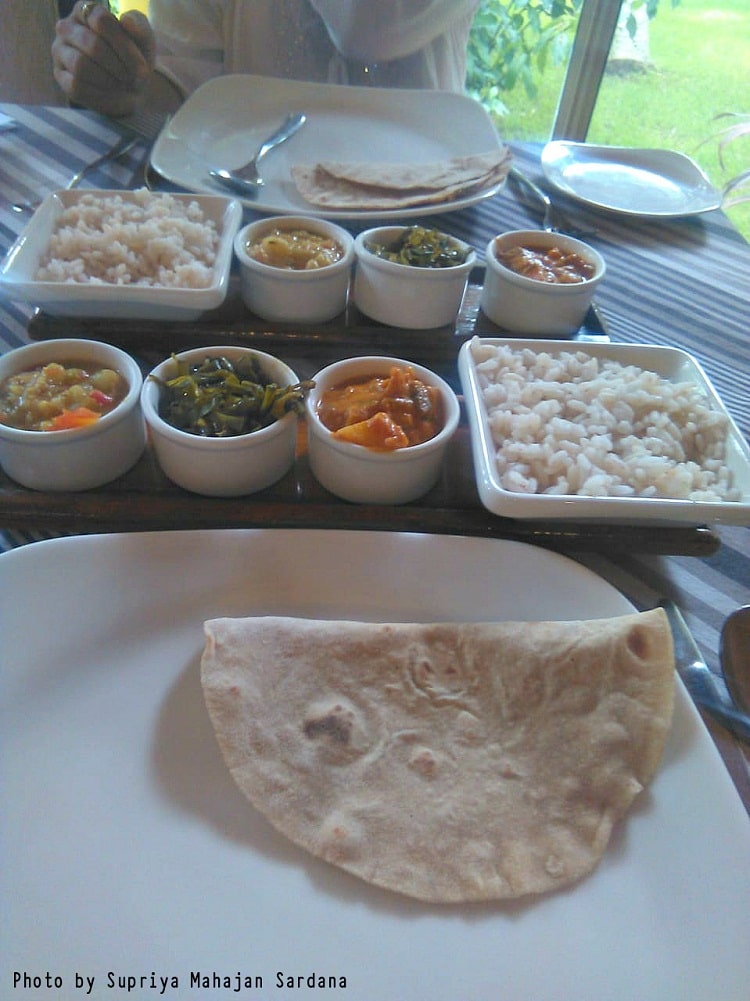 Tridoshic meals served in well proportioned platters curb overeating and wastage |
The amiable staff gave us a traditional welcome, with a cooling sandalwood teeka†, and aarti‡ with a gleaming brass lamp surrounded by crimson seeds of Red Sandalwood, Rakta Chandan or Manjadikuru (believed to be Lord Krishna’s favourite). It is said that a seed contains all five elements of Nature—Earth, Water, Fire, Air and Ether.
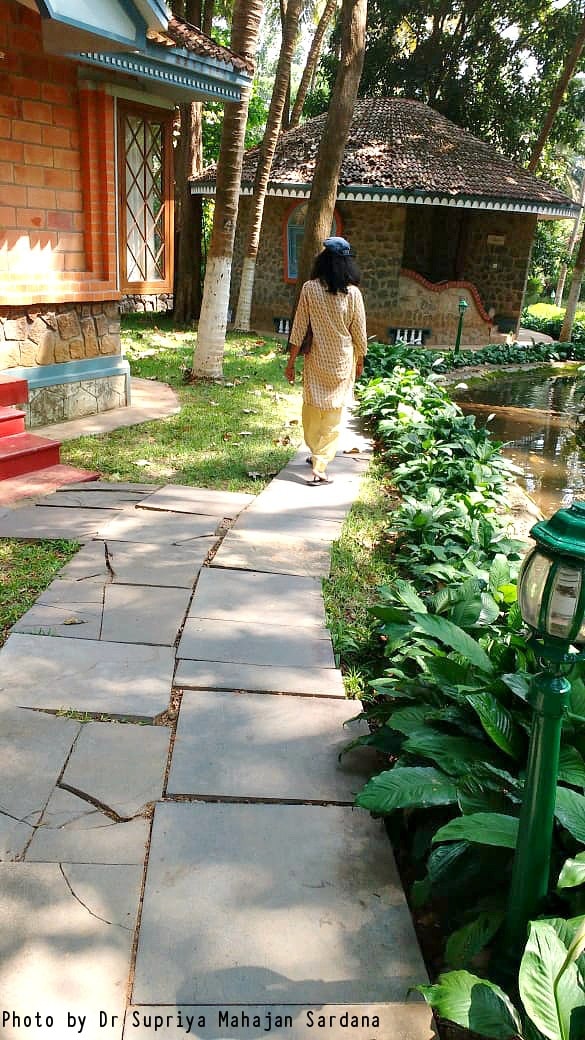
Use of Mangalore tiles, bare brick design and incorporation of local materials
The sprawling retreat is spread over 60 acres, with only 14 acres constituting built-in area. It became operational in 1999 as part of the vision of its founding couple, KV and Gita Ramesh, to carry on Ramesh’s hundred years’ old family tradition of Ayurvedic healing.
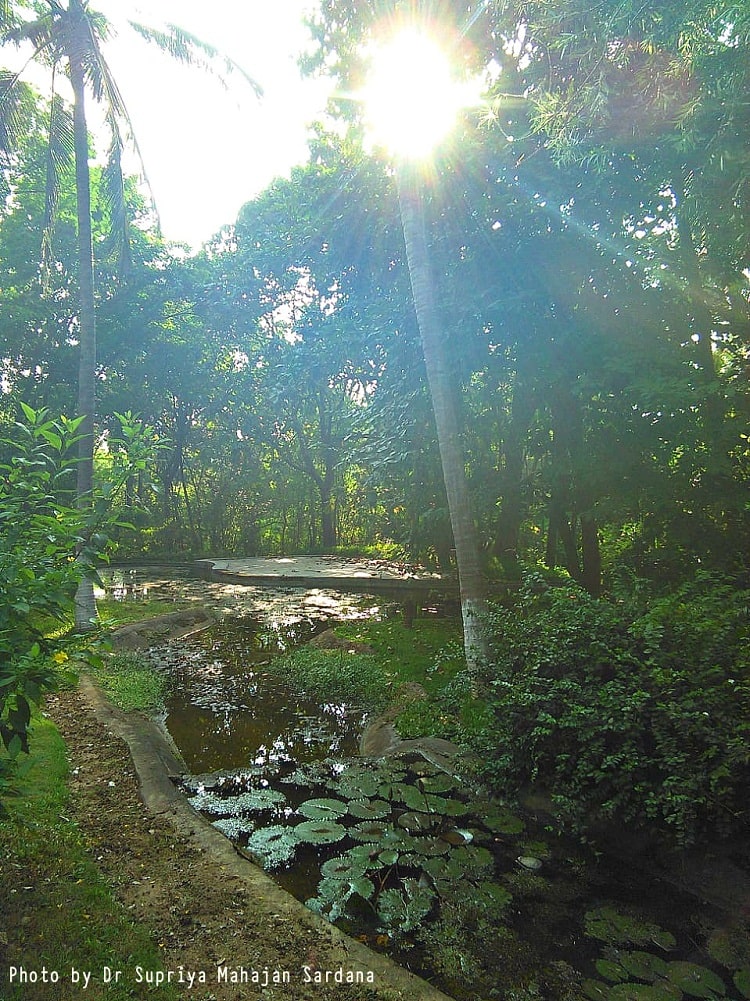
The theatrical interplay of the five elements in Nature
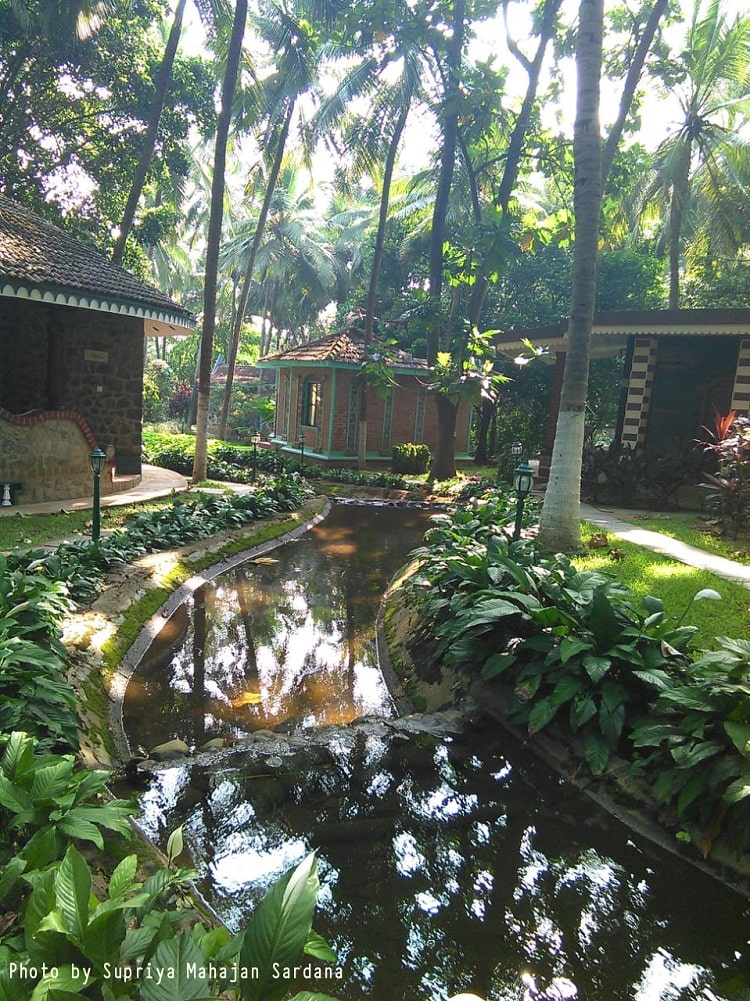
Green environs and green buildings designed on the principles of the revered architect, Laurie Baker
All the buildings in the retreat have been sustainably designed on the principles of the revered architect, Laurie (Lawrence Wilfred) Baker, also known as the Gandhi of Architecture, for his role in the revival of regional building practices and use of local materials. Although each cottage is a unique blend of aesthetics and architecture, they are testimony to Bakeresque ethics of frugality of design, with minimum use of plastering and superfluous decorations. The latticed bare brick jaali§ work, particularly in the walls of the ayurvedic hospital, next to the manmade pond, has been incorporated to keep the building cool. The buildings are not just energy efficient but form the perfect backdrop for the theatrical interplay of the five elements in Nature.
The stately trees, the burst of floral colours, the bouquet of natural scents permeating the air—all vie for one’s attention. On a leisurely walk through the retreat, it is difficult to ignore the large number of butterflies floating by. Approximately 48 species of butterflies have been spotted and recorded by an expert during his stay here, further underlining the environment friendly practices being followed.
As we settled down in our Zen-like cottage, we were bathed in serenity. In the process of connecting with Nature, we had already slowed down and felt rejuvenated, even before the much needed Abhyanga, a full body, four-hand, herb infused oil massage.
OUR BODIES ARE AN EXTENSION OF THE UNIVERSE
During an introductory lecture, the ayurvedic physician reiterated the Puranic¶ aphorism, Yatha pinde tatha brahmande, meaning: Man is amicrocosm of Nature and the five basic elements, which constitute all. The Universe also exists within an individual. From these five elements manifested in the human body originate the trinity of Doshas or humours, namely Vata, Pitta and Kapha, which decide our individual constitution or Prakruti, which further governs all our psychosomatic functions.
All foods and experiences have an effect on the overall balance of these three doshas. The wind blowing through the trees, the sun shining on your face, its warmth pervading your body, the indescribable beauty of the Water Apple tree in full bloom, the grounding effect of the earth, the gently flowing water body, the tridoshic** meals— all pacify one dosha or the other. In this haven of natural energy, with the groundwork done, we felt more receptive and open to healing.
FOOD IS THY MEDICINE
I have been trained as an allopathic physician. The reductionist approach of this system of medicine has relegated food to a forgettable set of calorific numbers and RDA (Recommended Dietary Allowance) of nutrients. Many years ago, when I discovered the basic tenet of Ayurveda, ‘Aahaar hi aushadhi hai’††, delineating what, when and how to eat, I became an ardent follower for life.
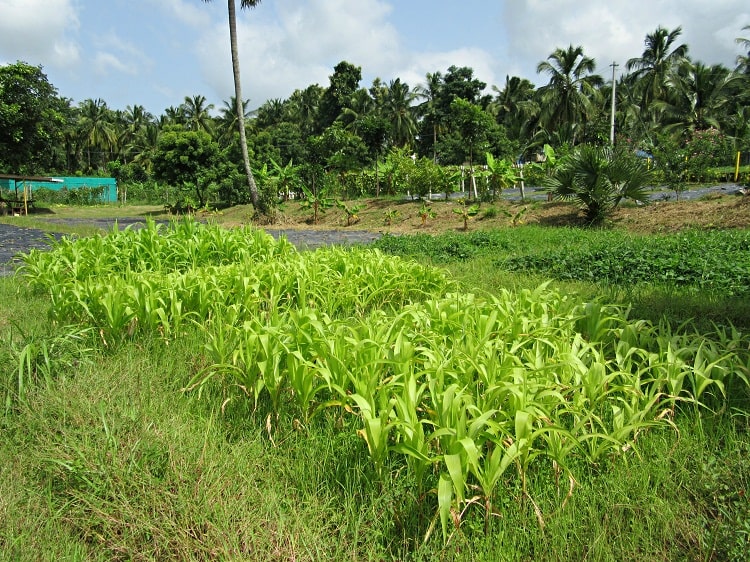
KHV grows its own organic herbs, vegetables and paddy and is home to more than 120 species of organic trees
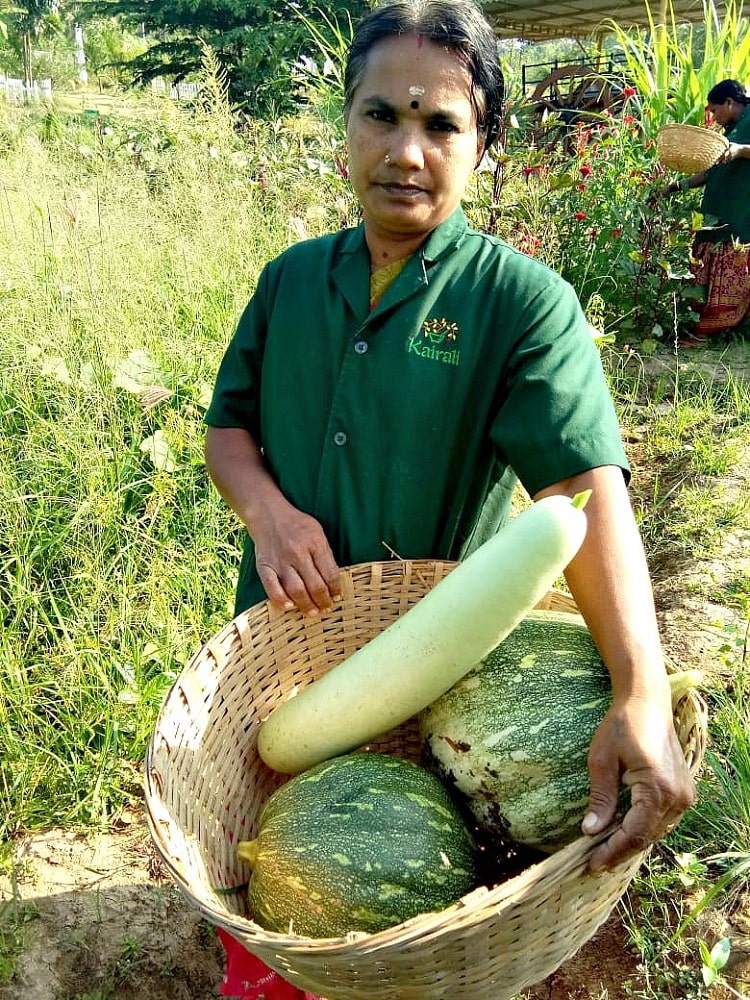
But how can food, which is indiscriminately laced with toxic chemicals throughout its entire journey from farms to our tables, keep us free from disease? There are very few instances in the hospitality industry, which meet my travel prerequisite of availability of farm fresh organic food, eaten either raw or cooked simply with safe ingredients. Kairali’s signature retreat fits the bill perfectly.
The meals are well balanced and served in appropriately proportioned platters, which is pleasing to the eye (hence, gets your digestive juices flowing!) and tastes divine. Long after the meal, the silky texture of the locally grown rice, Matta, which we tasted at the retreat, stayed with me, highlighting the significance of pure, local and natural ingredients. This approach not only limits overeating but also minimises food wastage.
Soon, the option of eating meals in Sukhasana or the cross-legged sitting position, considered the best for digestion, will also be incorporated in the retreat’s dining format. Here, herb infused (Pathimukham) warm water is provided in steel flasks in the room, as well as, in the canteen.
COMMITTED TO GOING ALL THE WAY: SUSTAINABLE AGRICULTURE
Under the guidance of a trained agri scientist, KHV grows organic herbs, vegetables and paddy. There are more than 120 species of organic trees on the property. The total number of trees on the entire property (including non organic ones) is 6,000, and they include fruit trees such as guava, sapota, banana, papaya, lime, cherries, Indian gooseberry, mango; medicinal trees like Nux vomica, Wrightia tinctoria, frankincense and neem; as well as, palm, native jackfruit, breadfruit, ficus and kino, to name a few.
An animal farm on the property—which is also the favourite haunt of the staff for an energy recharge—ensures a constant supply of natural manures for the organic farms. The kitchen and horticulture waste is either used in the farm or is composted. This commendable return to integrated farming has rendered the founders’ vision foolproof.
AYURVEDIC HOSPITAL
The purpose of Ayurveda is not to cure a particular disease, but to bring each individual to his or her own state of harmony. Hence, for deep-rooted and chronic diseases, the treatments are individualised taking into account not only the Vikruti or the condition but also the Prakruti or the nature of the patient.
Guided by age old methods, there is an exhaustive list of treatments that are delivered through mostly inhouse organic herbs and pure, natural oils. Unlike many mushrooming Panchkarma centres, I learned, to my relief, that Panchkarma is not touted to be the be-all and end-all of ayurvedic treatments at the ayurvedic hospital in KHV. It is neither recommended nor performed as a detoxifying or destressing regimen for all and sundry, rather it is administered carefully to those whose disease condition warrants it.
HOLISTIC & HEARTWARMING EXPERIENCE
A day at KHV aims towards an amalgamation of Ayurveda, Yoga and meditation. When heading here, one ought to leave one’s baggage behind, both literally and figuratively.
As my friend put it, all that we needed during our stay could fit into a polybag. Heartwarming memories of a doctor soothing a distraught patient, light hearted antics of a foreign guest perfectly at ease with his surroundings, witnessing the concern of the staff for a goat in labour and love for the newborns of another, lend an endearing quality to the place.
Led by an unassuming general manager, the staff is eversmiling and unobtrusive, yet happy to help. The management is open to queries, discussions and suggestions. Their commitment to making one’s stay comfortable and worthwhile puts one at ease.
AYURVEDA: THE SCIENCE OF DAILY LIVING
The strength of Ayurveda lies in its all-encompassing approach to the dynamic inter-relationship between our physiology, diurnal rhythm, emotions and external factors like diet, lifestyle and Nature’s cycles. According to ayurvedic texts, most ailments can be handled without a physician.
In the present context, the role of an organic health retreat like Kairali – The Ayurvedic Healing Village, which is steeped in this wisdom, becomes significant, as it is not just another facility for relaxation. Rather, it is a proof of living Ayurveda and its practical application in our lives. Moreover, in today’s harrowing times, perhaps we need more than a few feel-good (superficial) massages in pseudo spa centres.
TAKE HOME MASSAGE
Learning how to do a self-Abhyanga had been on my to-do list since ages but I never really ventured that far. During my stay at the retreat, I not only learned the ‘how-to’ but more importantly the ‘why’ from doctors there. Ever since my return, a full body massage with sesame oil has been part of my routine at least twice or thrice a week. And what a difference such a small change has made to my chapped lips, cracked feet, hair and dry skin woes!
A few days’ stay at places such as this perhaps cannot bring radical changes in one’s body, mind and consciousness, but it does pave the way for the revival of Ayurveda in our lives and spur us on the road to recovery and self healing. À santé!
*The droni in KHV is made of medicated wood.
†In Hindu tradition, guests are often welcomed with a teeka or tilak, a vertical smear on the forehead, made with turmeric, red sandalwood or vermilion paste.
‡In Hinduism, aarti is an act of worship, wherein a sacred flame is lit to honour God. Guests are often welcomed with aarti to establish their visit as auspicious.
§Net-like.
¶Belonging to the Puranas, a genre of ancient Indian literature.
**Catering for all 3 doshas.
†† Food is medicine.
The author is a dermatologist in Delhi NCR, as well as, an ardent follower of Ayurveda. Deeply influenced by the books ‘Ayurveda: The Science of Self Healing’ by Dr Vasant Lad, as well as, ‘The Yoga of Herbs’ by Dr David Frawley and Lad, she is inspired to delve into the parent texts, Charaka Samhita and Ashtanga Hrudayam


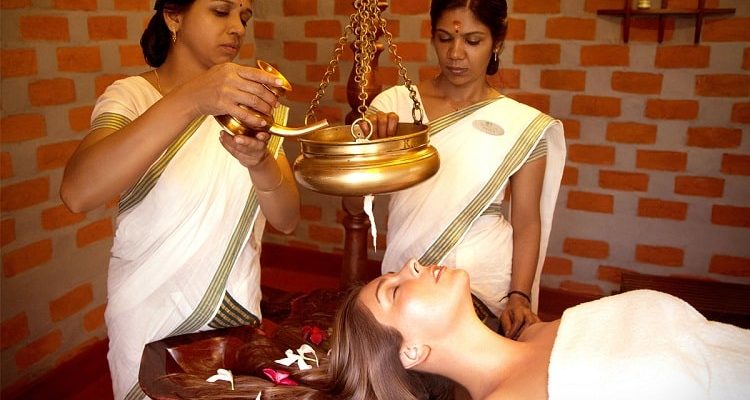
May I know which architect done this healing village
I have a tingling back pain, would like to take a treatment. How days the course and price..tq
Kindly contact Kairali directly.